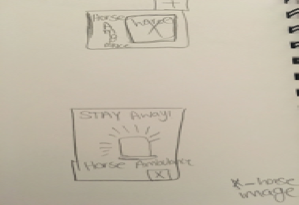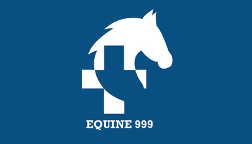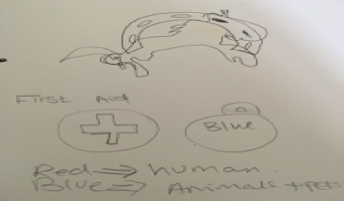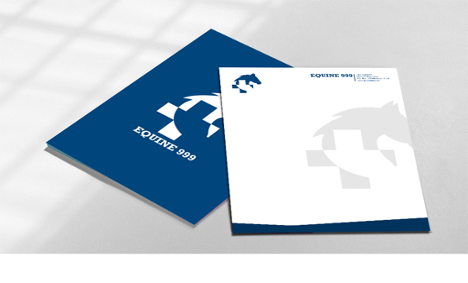Abstract
Well-designed posters are an effective way of conveying information on existing social issues and strategies to solve them. To this end, the senior project paper aims at analyzing the process of solving the preventable death of animals during horserace by passing information using designed posters and stationary. It describes the project related to the creation of an ambulance for horses in the United Arab Emirates. The paper emphasizes the topicality of the current issue. It presents the results of the research and the measures taken to develop the idea of the project. Also, it introduces the proposed solution.
Introduction
Horseracing has remained a source of entertainment for people all around the world for hundreds of years. For racehorses to stay fit for contests, several care procedures are necessary before and after the races. Bird (2008) notes that horses should be handled with care during transportation. Even though horseracing has been around for decades, most racers lack sufficient knowledge on how to care for their animals.
There are various ways of alerting the public on key issues that need to be taken into consideration. One of the approaches entails starting awareness campaigns. According to Ager (2009), the campaign acts as one of the most efficient methods of alerting masses and relaying important information. The reason for this is that the approach has a striking effect on the human subconscious. Campaigners need to design posters. A quality design created professionally acts as a promotional instrument. Also, it attracts peoples’ attention.
In this paper, the author will focus on promoting a campaign aimed at creating awareness on how to care for racehorses. The posters and stationery for the campaign are blue. A horsehead picture is used as the logo. The campaign aims to alert the public, horse racers, and the UAE’s sports organizations on proper horse handling procedures.
The Rationale for Choosing Ambulance for Horses’ Project
The main reason for choosing the project is to help manage high injury rates witnessed annually during racehorses. Lack of trained animal and medical personnel and ambulances to ferry the injured ponies to animal clinics is one of the causes linked to the death of the animals. Fraser (2010) notes that about 600 to 700 race stallions succumb to severe injuries incurred while racing. Some of the horses die during high profile races. If there were ambulances around the tracks, some of these deaths could be prevented. Racehorse trainers are charged with the responsibility of checking the physical condition of the stallions. As such, they have to ensure that they have ambulances to ferry ponies to clinics when severe injuries are sustained.
An Overview of Horseracing in the UAE
Horseracing is organized on an official basis in the United Arab Emirates since 1991. King (2008) argues that there are four main tracks used for the sport. They include Meydan, Abu Dhabi, Jebel Ali, and Sharjah. Out of the four, the Meydan is the only one that can be used in any weather. Horseracing in the United Arab Emirates witnessed major development and popularity after a series of successful jockey challenges held in 1993, 1994, and 1995. Over the past few decades, extensive promotion campaigns have been carried out to persuade racers to use purebred Arabian horses (Sulayem, 2013).
Despite UAE holding horserace competitions for more than a decade, the nation belongs to the category of countries where the equine sports sector needs the appropriate infrastructural developments. Establishments and specialists providing decent care for horses should be the first element of equine sports’ facilities. The country has made huge advancements in animal care practices. However, several issues remain unresolved. Due to this, various developments and innovative improvements are required. The call to improve the care for horses shows the need for a project to develop the idea of creating ambulances for race stallions. The ambulances will provide safe, fast, and urgent help to the injured ponies.
The project should involve horses’ transportation to the medical centers and the provision of the necessary first aid measures. The move will prevent deaths related to horse injury and increase the chances of saving the animal’s life. Also, the ambulances can provide transportation of dead stallions to the municipality for appropriate actions. Ferrying them to the municipality will curb such practices as the chaotic burial of dead horses or throwing of the carcasses in the desert.
Factors Associated with UAE’s Horserace Injuries
Before Race Horse Care
Poor care of horses before races is one factor associated with the high injury rates (Gimenez, Gimenez & May, 2008). Racers need to employ trainers if they are not capable of efficiently taking care of the animals. According to King (2008), a horse trainer in the UAE requires a state’s license to carry out their duties. Stallions, just like athletes, need care before races. Some of the actions taken to ensure fitness is ice and heat therapy. The therapy eases leg aches and pains among the animals. Putting the legs of the mare in ice daily is essential for treating ligament inflammation. Heat therapy helps to increase blood flow to sore areas (Frank & Drape, 2012). Another important feature is daily exercises employed as means of preparing the horse for the next race.
After Race Horse Care
Poor after race care has been associated with the high number of deaths among horses. Once a contest is over, ponies need checkups to ensure that everything is normal. The evaluation entails checking for any injuries sustained during the race and overall health. Bird (2008) observes that it is important to walk the horse after a race until its heart rate returns to normal.
If the care factors are taken into consideration, the number of injuries during races will reduce. Fewer horses will require ambulance transport to animal clinics.
The Link between the Project’s Idea and the Designer’s Professional Development
The work of a designer requires high levels of creativity. Most people consider the duty to be a simple task. However, the work is often complicated and requires designers to create logos that relay the desired message with ease. The professionalism of a designer is equal to the quality of the design product. It affects the success or failure of the business or the issue it represents.
Consequently, a designer should extract the primary aspects of the problem from the multiple components and form the needed message correctly. They should take into account the current social challenges and the expected results. The project’s idea allows the designer to go through all the steps and successfully position the crucial issue using design instruments. The UAE society must promote awareness regarding the responsibility and challenges of designers’ work. The campaign will show the significance of the profession and lead to its development.
Description of the Work Before the Project
Before developing an idea, the designer needs to investigate the country’s current situation, urgent challenges, and similar practices existing in the area of interest. Consequently, the latest specialized news in the mass media, such as The National, The Telegraph, The Daily Mail, and Horsetalk.co.nz, were consulted to understand the domestic situation in light of the current challenges. Statistical data were collected using official sources, including from The Arabian Horse Association. Also, professional medical sources, such as reports from the Centre for Equine Health and Canadian National Farm Animal Care Council, shed more light on horses’ physiology.
The information was also used to determine the priority of improving the animals’ welfare. All these sources influenced the process of developing the project. They also promoted the formation of a consistent vision of the idea. The design of the first horse ambulance in 1867 by the American Society for the Prevention of Cruelty to Animals highlighted the unusual design of future ambulances for horses in the United Arab Emirates (Thomas, 2013). EquinSpirits was used as a modern example of companies providing equine ambulance facilities. The operations of the company highlighted the nuances of the functionality of the vehicle’s internal planning (Video tour, 2016).
It is important to note that the ambulance’s functional part’s creation and design may be the most complicated task in the project. It needs specialized and accurate technical and medical knowledge. Consultations with the appropriate specialists will be required to complete this part of the project.
Identified Structure and Features of the Horse Ambulance
Horse care ambulances should have a front and rear loading ramp. The parts should be hydraulically operated. They should be able to drop down to the ground level. Also, the ambulance should have an adjustable partition, drag-mat, sling, and winch. The ideal width should be at least 8 feet. According to Gimenez et al. (2008), a horse ambulance should have enough space to act as a temporary veterinary treatment room. Big ambulances allow animal health experts to attend to more than one horse at the same time. The figure below is a sketch representation of the horse ambulance:

An equine ambulance should be well equipped to provide immediate basic emergency care. Some of the elements required in the trailers include a sled to load severely injured stallions, oxygen supply with a demand valve, basic medication, and pharmacy supply, and fluid administration sets. Other important items required in the equine ambulance include endotracheal tubes, fiberglass casting, and bandaging materials, anesthesia equipment, and basic surgical supplies. According to McIlwraith and Rollin (2011), a horse ambulance’s primary function or purpose is to provide a humane, comfortable, and safe way to mobilize injured racehorses while administering emergency care until the horse reaches the animal hospital.
The Concept of the Senior Project
The United Arab Emirates is famous for its highly developed equine sports infrastructure. The Arabian horses belong to the most valuable breeds. Their number is approximately 7,000 (Arabian horse statistics, 2015). Besides, many horses participate in various national and international sports events. The number of animals taking part in these activities is almost 500 horses in a given season (Racing statistics, 2016).
It is no surprise then that horses are an integral part of the country’s traditions. The culture of the Arabian societies is inextricably linked with these animals (Passela, 2016). As such, the country has a fairly well-developed horse care infrastructure. However, a large number of sports are the primary reason for high-risk accidents. According to the Centre for Equine Health, orthopedic injuries account for many diseases occurring during the races (“Equine fractures: Improving the chance for a successful outcome,” 2011). Such traumas can be treated fast. However, they may have severe impacts on the animals’ welfare if the first aid is not provided in time (Miller, Stull & Ferrarro, 2014).
It is rather complicated to operate with the data available on the lethal accidents during the races. The reason is that the statistics do not reflect reality. According to non-official data sources, around 80 deaths occur after returning home from races (Samuel, 2013). At the same time, it was officially reported that six fatalities took place in the United Arab Emirates this season (Clarkson, 2016). The difference in the figures is rather significant. However, even if one considers the average of the two sets of statistics, it is apparent that there is an urgent need for horse aid.
All over the world, the welfare of animals is analyzed from the perspective of the Five Freedoms. They include freedom from pain, injury, and disease (Code of practice for the care and handling of equines, 2013). Providing first aid services, especially during racing, is the horse owners’ primary duty and other stakeholders (Cuckson, 2016). Horse ambulance is the best way to provide timely and professional care worldwide.
Campaign Stationary and Design for Posters
The campaign posters and stationery for the Ambulance for Horses Project are blue. Their design is borrowed from the shape of a horse head. The selection of the design was based on various factors. For example, the decision to use a horse head was influenced by the fact that the entire awareness campaign revolves around providing care for stallions.
The figures below show the sketches used to come up with the official design:

Using the picture of another animal as the official logo for the posters will not send or pass a clear message regarding the issues that need consideration. It would be ironic to design posters and stationery with cat or dog pictures as logos when creating awareness about horses.
The figure below shows the stallion head and the cross shape, which represent the official logo:

The posters have the word ‘Equine.’ The term represents people dedicated to the care of sick and injured horses. These experts’ responsibility is to provide a wide range of services, such as therapeutic massage, to race stallions. McIlwraith and Rollin (2011) think that equines are equipped with extensive technical skills and knowledge on the musculoskeletal structure of horses. They are also knowledgeable about the animal’s biomechanics, acupressure points, and aromatherapy.
Another distinct feature of the poster design is the use of the color blue. The shade has more contradictory and complex meanings than any other color. In the case of the poster, the color choice was based on several reasons. One of the primary rationales is because blue is used for first aid in animals. The sketch below illustrates the application of color blue in animal and pets first aid:

Another rationale is because blue maintains its character in all tones. Also, it conveys understanding (Rivers, 2008). Color white is incorporated into the logo. The reason for using the color is to avoid the cliché associated with the overuse of blue. The poster design also has a cross shape at the horse head’s neck. The cross is a depiction of the campaign’s desire to reduce horse injury and fatalities. The sign represents aid.
The figure below shows the incorporation of blue and white color into the poster designed for the campaign:

The Process and Proposed Solution
After analyzing the tradition associated with horses, prevailing challenges in equine sports, and international experiences in the project’s area of interest, this designer tried to find the intersection points between these elements. Through analysis and brainstorming, the designer determined the primary aspects of the visual solution. It should emphasize human responsibility for the animals and foster a feeling of satisfaction because of their efforts to solve the issue. Moreover, the visual solution should represent the horse ambulance as a new level in the national policy. The reason is that it will promote the image of safe racing.
Conclusion
The development of the project needs a rather multisided approach. The reason is that the idea has a significant moral, social, traditional, and economic context. The analysis was carried out to identify these elements, and their relationship with the issue addressed. Numerous research methods were applied to gather the information used in the creation of the final visual solution. The practice allowed for the fixation of the previous learning. It opened new perspectives for professional design activity, including meaningful social effects and being socially useful because of the primary occupation.
The use of design posters is an effective way of conveying information on existing social issues. It also provides information on how such problems can be solved. Consequently, the senior project paper highlighted the steps that should be taken to avert preventable horserace deaths. It achieved this by using information passed using designed posters and stationery.
Summary
In the Senior Project Research Paper, the author addressed creating a horse ambulance in the United Arab Emirates. The design is needed urgently. The designer analyzed the diverse elements associated with the challenges affecting the country’s active sports industry. The threats posed to the animals were also analyzed. The author came up with a visual representation of the solution. It entailed the design of the logo, the interior of the ambulance, and the promotion posters. The author focused on the importance of improving the welfare of racehorses (Mooney & Ennor, 2009). They emphasize the responsibility of the human actor concerning the wellbeing of these animals. The elements are the prerequisites for the implementation of this project.
The design outcome should be attractive to the people. The aim is to catch their attention, make them think hard, and finally, get their approval and further support for the project’s idea. By taking into account the objectives of this task and the fact that people will be more willing to participate in activities that address their interests, the designer decided to underscore the common national value of horses. The lasting traditions of the UAE community are the major uniting factors for this endeavor. Consequently, the author positioned the issue as a prerequisite to the restoration of the national customs and authentic culture, which is a significant part of each citizen’s personality.
As a result, the project will be highly successful. It will have greater national and international significance. Such a position implies that the horse ambulance is a tribute to the traditions of the country. It enhances the desire of the citizens to improve the welfare of these animals. Moreover, such an approach allows for the development of a unique retro-visual concept for the project.
References
Ager, M. (2009). Art and design. Cheltenham: Nelson Thornes.
Arabian horse statistics. (2015). Web.
Bird, J. (2008). Horse care and fitness. Neptune City, NJ: T.F.H. Publications.
Clarkson, N. (2016). The problems in UAE endurance are far from over. Web.
Code of practice for the care and handling of equines. (2013). Ottawa: Equine Canada and National Farm Animal Care Council.
Cuckson, P. (2016). FEI cancels UAE races in ’emergency measure’ over horse welfare. Web.
Equine fractures: Improving the chance for a successful outcome. (2011). Horse Report, 29(3), 1-3.
Frank, A., & Drape, J. (2012). Horse racing. Atglen, PA: Schiffer Publishing.
Fraser, A. (2010). The behaviour and welfare of the horse. Wallingford, Oxfordshire: CABI.
Gimenez, R., Gimenez, T., & May, K. (2008). Technical large animal emergency rescue. Ames, IA: Wiley-Blackwell.
King, D. (2008). United Arab Emirates. New York: Marshall Cavendish Benchmark.
McIlwraith, C., & Rollin, B. (2011). Equine welfare. Oxford: Wiley-Blackwell.
Miller, G., Stull, S., & Ferrarro, G. (2014). A Guide: Minimum standards for horse care in the State of Caroline. Davis: Centre of Equine Health.
Mooney, B., & Ennor, G. (2009). The complete encyclopedia of horse racing: The illustrated guide to the world of the thoroughbred. London: Carlton.
Passela, A. (2016). Shateh upsets stablemate Sha’Red on injury return at Al Ruwais Sprint in Abu Dhabi.
Racing statistics. (2016). Web.
Rivers, C. (2008). Logo-art: Innovation in logo design. Crans-Près-Céligny: RotoVision.
Samuel, M. (2013). Sport is not about driving horses to their deaths. Web.
Sulayem, M. (2013). Sport management in the Middle East: A case study analysis. London: Routledge.
Thomas, S. (2013). ASPCA horse protection history: Life or lunch?. Web.
Video tour. (2016). Web.